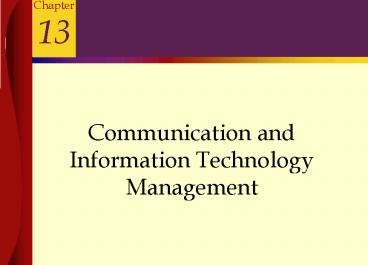Communication and Information Technology Management - PowerPoint PPT Presentation
1 / 21
Title:
Communication and Information Technology Management
Description:
The Communication Process. Figure 13.2. 13-11. Verbal & Nonverbal Communication. Verbal ... Nonverbal ... advantage of verbal and nonverbal signals. Provides for instant ... – PowerPoint PPT presentation
Number of Views:102
Avg rating:3.0/5.0
Title: Communication and Information Technology Management
1
Communication and Information Technology
Management
Chapter
2
Information and the Managers Job
- Data
- Raw, unsummarized, and unanalyzed facts.
- Information
- Data that is organized in a meaningful fashion
3
Attributes of Useful Information
4
Information Systems and Technology
- Information Technology the means by which
information is acquired, organized, stored,
manipulated, and transmitted
5
What is Information Technology?
- Management Information System An information
system that managers plan and design to provide
themselves with the specific information they need
6
Information and Decisions
- Most of management is about making decisions
- To make effective decisions, managers need
information, both from inside and outside the
organization
7
Information and Control
- Managers achieve control by
- establishing measurable goals
- measuring actual performance
- compare actual performance with goals
- take any corrective action
- Managers must have information to achieve control
over any organizational activity
8
Communication and Management
- Communication
- The sharing of information between two or more
individuals or groups to reach a common
understanding.
9
Communication and Management
- Importance of Good Communication
- Increased efficiency in new technologies and
skills - Improved quality of products and services
- Increased responsiveness to customers
- More innovation through communication
10
The Communication Process
Figure 13.2
11
Verbal Nonverbal Communication
- Verbal Communication
- The encoding of messages into words, either
written or spoken - Nonverbal
- The encoding of messages by means of facial
expressions, body language, and styles of dress.
12
The Dangers of Ineffective Communication
- Managers and their subordinates can become
effective communicators by - Selecting an appropriate medium for each
messagethere is no one best medium. - Considering information richness
- A medium with high richness can carry much more
information to aid understanding.
13
Information Richness
- The amount of information that a communication
medium can carry - The extent to which the medium enables the sender
and receiver to reach a common understanding
14
Communication Media
- Face-to-Face
- Has highest information richness.
- Can take advantage of verbal and nonverbal
signals. - Provides for instant feedback.
- Spoken Communication Electronically Transmitted
- Has the second highest information richness.
- Telephone conversations are information rich with
tone of voice, senders emphasis, and quick
feedback, but provide no visual nonverbal cues.
15
Communication Media
- Personally Addressed Written Communication
- Has a lower richness than the verbal forms of
communication, but still is directed at a given
person. - Excellent media for complex messages requesting
follow-up actions by receiver - Impersonal Written Communication
- Has the lowest information richness.
- Good for messages to many receivers where little
or feedback is expected (e.g., newsletters,
reports)
16
Information Overload
- A superabundance of information that increases
the likelihood that important information is
ignored or overlooked and tangential information
receives attention
17
The Information Technology Revolution
- Computer Networks
- Networking
- The exchange of information through a group or
network of interlinked computers - Servers are powerful computers that relay
information to client computers connected on a
Local Area Network (LAN).
18
Types of Information Systems
- Transaction Processing Systems (TPS)
- Systems designed to handle large volumes of
routine transactions. - First computer-based information systems handling
billing, payroll, and supplier payments. - Operations Information Systems (OIS)
- Systems that gather, organize, and summarize
comprehensive data in a form of value to
managers. - Can help managers with non-routine decisions such
as customer service and productivity.
19
Types of Information Systems
- Decision Support Systems (DSS)
- An interactive computer-based management
information system with model-building capability
that managers can use when they must make
non-routine decisions
20
Types of Information Systems
- Expert Systems and Artificial Intelligence
- Employ human knowledge captured in a computer to
solve problems that ordinarily require human
expertise. - Uses artificial Intelligence to recognize,
formulate, solve problems, and learn from
experience.
21
Limitations of Information Systems
- Loss of the Human Element
- Information systems cannot present all kinds of
information accurately. - Thick information, which is rich in meaning and
not quantifiable, is best suited to human
analysis. - Information systems should support face-to-face
communication, and not be expected to replace it































